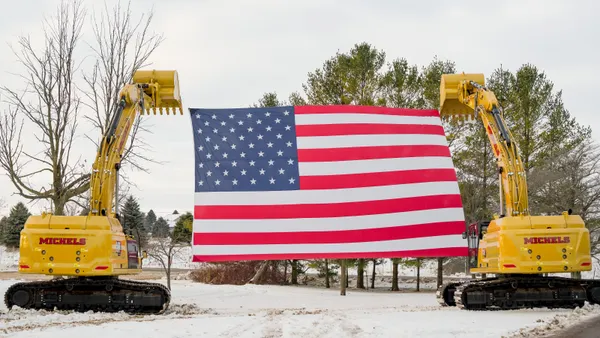Dive Brief:
-
An anticipated decline in the value of nonresidential starts is pushing down ConstructConnect's projection for growth in the value of 2017 year-over-year construction starts from 4.8% as of Q2 to 4.5%, per its Q3 2017 Construction Starts Forecast Report. Growth for the rest of 2017 will be driven by gains in residential (4.8%) and civil engineering (16.5%).
-
The slight decrease in nonresidential construction forecast for Q3 follows that category's year-over-year decrease of 17.9% in Q2. Residential and civil engineering, however, saw Q2 increases of 6.1% and 19.4%, respectively.
-
Oil and gas infrastructure projects will help propel growth in the civil engineering category for the rest of 2017 and beyond. An anticipated private investment-led program of general infrastructure improvements has the potential to positively impact the civil engineering category as well.
Dive Insight:
The construction industry is waiting for the promised bump in activity from an aggressive federal rebuilding program, but other priorities like healthcare have shifted the administration's focus. President Donald Trump is expected to present more details on his plans for surface transportation and other public asset improvements later this year, when Congress returns from its August recess.
So far, the only infrastructure specifics the White House has released have been suggested cuts to popular programs like the Transportation Investment Generating Economic Recovery (TIGER) grants and Capital Improvement Grants (CIG), as well as an overall reduction in U.S. Department of Transportation funding.
The industry is playing wait and see, however, in anticipation of the administration's full infrastructure plan. That program is expected to include a federal contribution of $200 billion to spur another $800 billion in private investment. Congressional work on the final bill could be delayed until 2018, however.
The Senate isn't waiting on Trump's full reveal, though. It has made allowances — and even some increases — for many of the programs the administration proposed cutting, such as discretionary funding for the USDOT and the TIGER and CIG programs.
And while the oil and gas infrastructure segment stands to gain from an increase in energy projects, it also must overcome resistance concerning the environmental impact of that work. The $3.8 billion Dakota Access pipeline project has been met with protests by Native American tribes on the grounds that its path underneath a lake near the Standing Rock reservation in North Dakota could potentially contaminate drinking water.
Most recently, the West Virginia Department of Environmental Protection ordered Energy Transfer Partners, the same company behind the Dakota Access project, to stop work on the $4.2 billion Rover pipeline due to sediment deposits, inadequate erosion controls and other agency concerns.












